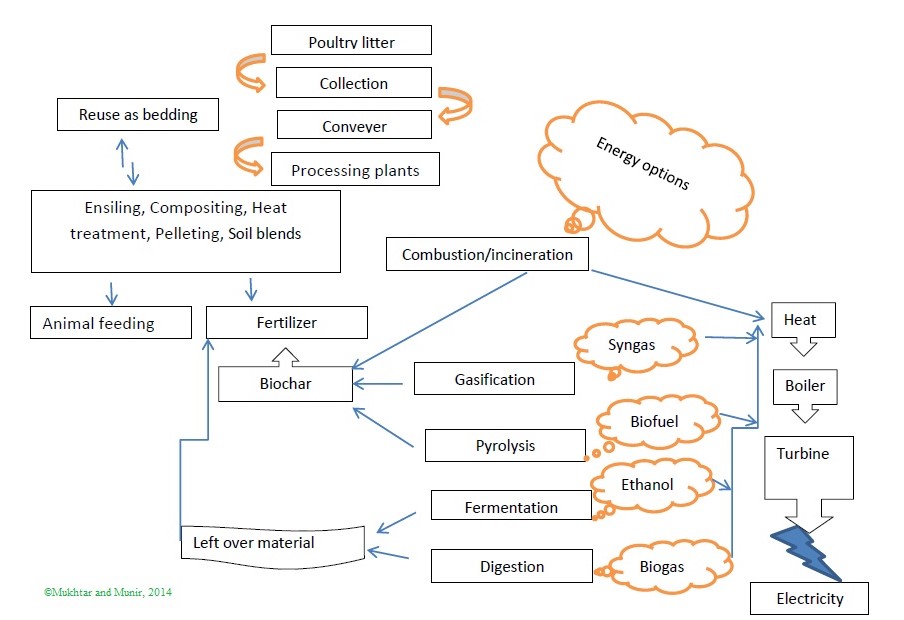The poultry industry is the fastest expanding agriculture sector. The growth of this sector is also increasing the waste products linked to production operations. The main waste product is "poultry litter" which mainly contains the bedding material and the bird droppings. Although large quantities of poultry litter are being produced in poultry farms, it has limited disposal options. The direct open land spread or dumping can lead to problems of greenhouse gasses emission, water quality issues, pathogenic hazards. Therefore, treating poultry litter (for reuse or energy production) could reduce these problems.
- poultry litter
- animal bedding
1. Definition
Poultry litter is a combination of aviary excreta and bedding materials such as wood shavings, sawdust, peanut hulls, shredded sugar cane, straw, or other dry, absorbent, uneaten feed, broken eggs, dead birds, bird feathers and low-cost organic material [1].
2. Introduction
The global poultry production is increasing day by day. About 111,000 thousand metric tons of poultry were produced in 2015. These numbers are expected to increase by 24% taking the total production 131,255 thousand metric tons in 2025. Likewise, poultry litter generation is also increasing. The poultry litter should be disposed of properly because of the following risks:
- Excess nutrient in the soil due to land application
- Contamination of drinking water
- Eutrophication of surface waters
- Ammonia emission from poultry houses
- Soil acidification through nitrification and leaching
- Biosecurity concerns
- Transmission of disease-causing pathogens
- Excess nutrient in the soil due to land application
- Contamination of drinking water
- Eutrophication of surface waters
- Ammonia emission from poultry houses
- Soil acidification through nitrification and leaching
- Biosecurity concerns
- Transmission of disease-causing pathogens
The price paid for poultry litter buying varies according to distance from the plant, litter quality, litter moisture content, and time of year. Poultry litter is collected after one or more flock removal. It is collected to carry out of the shed and can be transported to processing plants that may be inside the farm or outside on a distance. Poultry litter after collection is conveyed to plants where it can be processed or decomposed.
43. Uses of poultry litter
The poultry litter can be used in a number of ways as shown in Fig 1.
Figure 1. Potential uses of poultry litter
Potential uses of poultry litter.
43.1. Direct applications
The main and conventional use of poultry litter is to use for land application as fertilizer [2]. The recent price hike of commercial fertilizer has created a demand for poultry litter as fertilizer. It is rich in nutrients like phosphorus and nitrogen, so it is very suitable for lands that are deficient in nitrogen and phosphorus. Another direct use of poultry litter is the fertilization of fish ponds in order to promote algal growth.
These applications can result in a disturbance of the water quality by leaching and nutrient loading, transmitting pathogens. Certain type of drug residues, heavy metals and hormones are present in poultry litter those may affect the living bodies.
43.2. Conversion into value Added product
The composting of litter produces a valuable fertilizer that can be used in land applications as mentioned above. This resultant can also be used to make pellets, ruminant ration and soil blends for pottery. Compositing also generates heat at about 60 C which can be used to warm the water and heat the farms.
The Poultry litter with certain modifications can be fed to animals as a crude protein source. However, some countries have banned this practice owing to biosafety concerns. In practice, it is either directly fed to animals or used in ensiling along with fodder.
Raw and composted poultry litter can be used to make pellets that are concentrated in nutrients and have slow release. This process makes handling, transport and use easier. Pelleting is done by heating and compressing and the resultant pellets can be sued as fertilizer, soil amendment, feed additive, or energy fuel.
Apart from the above mentioned options, the reuse of poultry litter is always an economical option. The reuse can be made possible by composting or using some physical (heating and drying) or chemical treatment (acidifiers). However, the final result is again the waste product.
43.3. Energy production from poultry litter
The current environmental crisis and depletion of fossil fuels require alternative energy sources, the poultry litter could be a substrate to be converted into clean energy by eco-friendly options e.g. anaerobic digestion, combustion, pyrolysis, gasification and fermentation [3]. Many poultry production farms are using poultry litter to fulfill their energy needs. It not only eliminates the problem of waste management but also makes them self sufficient in energy production. The energy is basically produced in forms of gasses or liquid fuels or as a by-product of decomposition.
References
- Munir, Muhammad Tanveer; Belloncle, Christophe; Irle, Mark; Federighi, Michel; Wood-based litter in poultry production: a review. World's Poultry Science Journal 2019, 75, 5-16, https://doi.org/10.1017/S0043933918000909.
- Nanthi Bolan; A.A. Szogi; T. Chuasavathi; B. Seshadri; M.J. Rothrock; P. Panneerselvam; Uses and management of poultry litter. World's Poultry Science Journal 2010, 66, 673-698, 10.1017/s0043933910000656.
- Mariusz Tańczuk; Robert Junga; Alicja Kolasa-Wiecek; Patrycja Niemiec; Assessment of the Energy Potential of Chicken Manure in Poland. Energies 2019, 12, 1244, 10.3390/en12071244.

